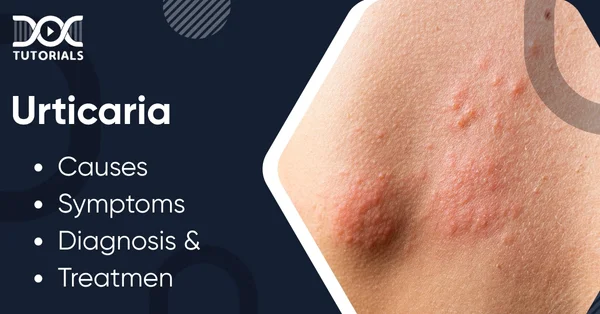Urticaria: Causes, Symptoms, Diagnosis, and Treatment

Urticaria, also known as hives, develops when an individual’s immune system is exposed to allergens, harmless proteins that can trigger allergic reactions. Depending on the severity, hives can be small or large. In most cases, they fade away within 24 hours, but can also be visible for several days.
Understanding the in-depth concept of hives is vital for medical students like you, who are preparing for the NEET PG exam. Therefore, keep reading to learn more about urticaria treatment, its diagnosis process, causes, and symptoms.
What is Urticaria?
Urticaria, commonly known as hives, is characterised by a splotch or welt (raised, red bumps) on an individual’s skin. This skin condition occurs due to an allergic reaction to a substance in the body and causes swelling on the skin surface. Individuals affected by urticaria often feel itchy, stinging, or burning sensations.
What are the Causes of Urticaria?
The urticarial rash may often develop without any reason, but here are some of the causes that can lead to the same:
Reaction to Allergens
Histamine is a protein released from one’s body during allergic reactions, followed by fluid leakage from capillaries (tiny blood vessels). Small bumps lead to rash and inflammation due to the accumulation of this fluid.
Such an allergic reaction occurs when an individual touches or consumes anything they are allergic to (an allergen). Here are some of the common causes of acute urticaria that occur due to allergens:
- Aspirin or other nonsteroidal anti-inflammatory drugs (NSAIDs)
- Some specific antibiotics
- Medicines that cure high blood pressure (angiotensin-converting enzyme inhibitors)
- Latex (mango, banana, chestnuts, or kiwi)
- Eggs, nuts, seafood or any other food allergen
- Food or cosmetic additives
- Poison ivy, nettles, poison oak, etc., plants
Underlying Health Problems
Here are some of the health conditions that can lead to urticarial rashes:
- Strep throat, urinary tract infection (UTI), and other bacterial infections
- Glandular fever, flu, hepatitis B, common cold, etc., are viral infections
- Autoimmune hypothyroidism
- Giardia lamblia or other intestinal parasites
- Systemic lupus erythematosus, celiac disease, rheumatoid arthritis, type 1 diabetes, Sjögren’s disease, etc. autoimmune conditions
- Other health conditions that cause inflammation in the blood vessels, etc.
Physical Triggers
An individual can develop urticaria due to the following physical triggers:
- Excessive pressure (for example, tying a belt tightly)
- Exposure to sunlight
- Rubbing or scratching the skin
- Exercise, sweating, a hot shower, or anxiety that increases a person’s body temperature
- Changes in temperature or extreme temperatures
- Adrenaline release that occurs due to exposure to stress, heat, or during exercise
- Rare cases, such as vibration or water on one’s skin, etc.
- UV (ultraviolet) light
What are the Risk Factors of Urticaria?
The risk factors of urticaria or hives are usually unpredictable. However, in some cases, the risk of urticaria disease increases due to the following medical conditions. Here are a few of those risk factors:
- Thyroid disease
- Cancer
- Infection
- Allergy
- Vasculitis (swelling of blood vessels), etc.
What are the Symptoms of Urticaria?
Urticaria symptoms depend on how an individual reacts to allergens and the source. Listed below are the common symptoms of urticaria:
- Extremely itchy rashes with burning pain and irritation
- Pink or red coloured welts at various parts of the body that turn pale upon pressing
- Uneven swollen welts and raised patches, ranging between 0.5-10 cm, without flaking and having distinct edges.
- Rashes occurring as well as disappearing within 24 hours
- Itchy rashes occur when exposed to sunlight, exercise, cold or hot weather, stress, sweat, etc.
- Rashes that occur two or three times a week throughout several months.
Individuals may also experience the following acute urticaria symptoms in case of severe conditions, such as:
- Respiratory issues like asthma, shortness of breath, airway obstruction, nasal congestion, etc.
- Rashes caused by urticaria rapidly spread throughout the affected individual’s legs, face, arms, mouth, around the eyes, and other parts of the body.
- Swelling of the eyes, lips, and face that is almost like angioedema.
- Vomiting, diarrhoea, abdominal pain, nausea and other gastrointestinal symptoms
- Low blood pressure, chest tightness, and other cardiovascular symptoms
- Joint pain, fever, and dizziness that can make one feel like fainting
How to Diagnose Urticaria?
Doctors usually diagnose urticaria disease by examining the affected individual’s skin and reviewing their history. A few of such diagnostic procedures include:
- Allergy Test
If the hives are acute, appear suddenly, and last for a short time, allergy tests can help pinpoint the trigger so you can avoid it in the future.
The most common allergy test is the skin prick or scratch test, where small amounts of different allergens are applied to the skin. If redness or swelling occurs, it indicates an allergy to that substance. This method is mainly used for acute hives, not for chronic cases.
- Blood Test
It is another option that helps measure specific antibodies, like IgE (immunoglobulin E), that an individual’s body produces in response to allergens. High levels of these antibodies can signal an allergic reaction, leading to hives and swelling. Identifying the cause helps manage and prevent future outbreaks.
What are the Treatment Options for Urticaria?
Treatment for chronic hives usually begins with over-the-counter antihistamines, which help control itching and swelling.
If these do not provide enough relief, your doctor may prescribe stronger medications such as montelukast, which is often added when antihistamines alone are not effective. Other prescription options include the following:
- Doxepin, a tricyclic antidepressant shown to reduce hives and itching
- Ranitidine, an H2 blocker sometimes used alongside antihistamines to improve symptoms
- Omalizumab, an injectable monoclonal antibody, is another option for persistent cases and stabilises the immune response.
For hives that resist these treatments, immunosuppressive drugs like the following may be used to suppress the immune system further and reduce symptoms:
- Cyclosporine
- Tacrolimus
- Hydroxychloroquine
- Mycophenolate
Acute urticaria treatment is often managed at home with antihistamines like cetirizine or fexofenadine to relieve itching and soothing or antiseptic creams to prevent infection. Short-term topical steroids may also help. If swelling affects the lips, face, or tongue, doctors may prescribe an epinephrine auto-injector for emergencies.
FAQs About Urticaria
- What are the complications of urticaria?
Complications of urticaria include angioedema, which causes deep swelling of the face or throat and can block the airway, becoming life-threatening. Another serious complication is anaphylaxis, a severe allergic reaction that leads to breathing difficulty, low blood pressure, and rapid heartbeat, requiring immediate epinephrine treatment.
- How to prevent urticaria?
To prevent urticaria, avoid known allergens like certain foods, medications, pollen, and stress. Wear loose, soft clothing and protect your skin from extreme temperatures and sunlight. Don’t scratch rashes to prevent worsening. Allergy testing, adequate sleep, and stress management also help reduce flare-ups.
- Are urticaria and rashes the same?
Hives or urticaria are rashes. They are raised, itchy bumps that appear quickly on the skin and usually last less than 24 hours. Pressing the centre makes it turn pale, helping doctors distinguish hives from other rashes.
Conclusion
Identifying the signs and symptoms of urticaria is essential to adopt the proper treatment method. Urticaria treatment is a crucial topic in the NEET PG syllabus. DocTutorials’ detailed study materials, top-notch video lectures, Quick Revision Programs (QRP), etc., are focused on providing you with the best guidance for NEET PG exams.
Want to secure top rank in NEET PG? Enroll in our NEET PG course today!
Latest Blogs
-

NEET SS Exam 2024: Analysis, Key Dates, Counselling
The NEET SS 2024 exam kicked off on March 29, 2025. Over two days and two slots, candidates across 13…
-

NEET PG Registration 2025: An Essential Guide For Exam Prep
The NEET PG registration, which is conducted online, is a crucial step in the exam process. Filling out the NEET…
-

NEET PG Syllabus 2026: A Must-Have Complete Guide for Exam Success
The NEET PG Syllabus acts as one of the foundation stones for aspiring postgraduate medical students like you who are…




